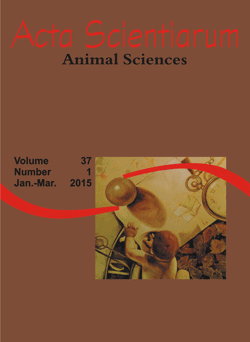<b>Energetic feedings influence beeswax production by <i>Apis mellifera</i> L. honeybees
Resumo
The effect of different types of energy feeding (sugar syrup, inverted sugar and juice of sugar-cane) on beeswax production and its economic feasibility are evaluated. Twenty beehives of Africanized Apis mellifera were selected, and five were used for each type of feeding. The treatments were T1 (sugar-cane juice), T2 (sugar syrup) and T3 (inverted sugar). Feedings was provided by Boardman feeders and the amount was adjusted according to consumption. A layer of beeswax was manually set up into the honeybee nest and beeswax built area was measured weekly. Total reducing sugar, calorimetry, dry matter and ashes of all feedings were analyzed. Data were analyzed by analysis of variance with Tukey’s test to determine differences among averages. The average consumption of inverted sugar was significantly lower than that of other treatments. The highest beeswax production average occurred in the sugar syrup treatment. The highest average of ashes, dry matter and reducing sugar occurred, respectively, in sugar-cane juice, inverted sugar and sugar syrup. Sugar syrup may be an alternative energy source for beeswax production, although sugar-cane juice may be more profitable.
Downloads
Referências
Brown, R. (2010). Beekeeping: a seasonal guide: London, UK: BT Batsford Ltd.
Castagnino, G. L., Arboitte, M. Z., Lengler, S., Garcia, G. G. & Menezes, L. F. G. (2006). Development of Apis mellifera cores fed with amino acid supplement vitamin, L. Promoter. Ciencia Rural, 36(2), 685-688.
Cui, Z.-W., Sun, L.-J., Chen, W. & Sun, D.-W. (2008). Preparation of dry honey by microwave–vacuum drying. Journal of Food Engineering, 84(4), 582-590.
Gratão, A. C. A., Berto, M. I. & Silveira Júnior, V. (2004). Reologia do açúcar líquido invertido: influência da temperatura na viscosidade. Ciência e Tecnologia de Alimentos, 24(4), 652-656.
Lomele, R., Evangelista, A., Ito, M., Ito, É., Gomes, S. & Orsi, R. (2010). Natural products in the defensive behaviour of Apis mellifera L. Acta Scientiarum. Animal Sciences, 32(3), 285-291.
Marchini, L. C., Reis, V. D. A. d. & Moreti, A. C. d. C. C. (2006). Physico-chemical composition of pollen samples collected by Africanized Apis mellifera (Hymenoptera: Apidae) in Piracicaba, State of São Paulo, Brazil. Ciencia Rural, 36(3), 949-953.
Mendes, G. C., Silva, J. B. A., Mesquita, L. X. & Maracajá, P. B. (2009). As análises de mel: Revisão. Revista Caatinga, 22(2), 7-14.
Pereira, F. d. M., Freitas, B. M., Vieira Neto, J. M., Lopes, M. T. d. R., Barbosa, A. d. L. & Camargo, R. C. R. d. (2006). Development of honeybee colonies under protein diets. Pesquisa Agropecuária Brasileira, 41(1), 1-7.
Sodré, G. S., Marchini, L. C., Moreti, A. C. C., Otsuk, I. P. & Carvalho, C. A. L. (2007). Caracterização físico-química de amostras de méis de Apis mellifera L.(Hymenoptera: Apidae) do Estado do Ceará. Ciencia Rural, 37(4), 1139-1144.
Sodré, G. S., Marchini, L. C., Moreti, A. C. d. C. C., Otsuk, I. P. & Carvalho, C. A. L. (2011). Physico-chemical characteristics of honey produced by Apis mellifera in the Picos region, state of Piauí, Brazil. Revista Brasileira de Zootecnia, 40(8), 1837-1843.
Wolff, L. F., Gonçalves, M. M., Medeiros, C. A., Welke, J. E., Reginatto, S., Ferreira, D., Vicenzi, R. & Soares, J. M. (2009). Beekeeping as a strategy for economic alternative to tobacco growing in family agriculture. Revista Brasileira de Agroecologia, 4(2), 1491-1494.
Yanniotis, S., Skaltsi, S. & Karaburnioti, S. (2006). Effect of moisture content on the viscosity of honey at different temperatures. Journal of Food Engineering, 72(4), 372-377.
Yusof, S., Shian, L. S. & Osman, A. (2000). Changes in quality of sugar-cane juice upon delayed extraction and storage. Food Chemistry, 68(4), 395-401.
Zar, J. H. (1999). Biostatistical analysis (4th ed.). Upper Saddle River, NJ: Prentice Hall.
DECLARAÇÃO DE ORIGINALIDADE E DIREITOS AUTORAIS
Declaro que o presente artigo é original, não tendo sido submetido à publicação em qualquer outro periódico nacional ou internacional, quer seja em parte ou em sua totalidade.
Os direitos autorais pertencem exclusivamente aos autores. Os direitos de licenciamento utilizados pelo periódico é a licença Creative Commons Attribution 4.0 (CC BY 4.0): são permitidos o compartilhamento (cópia e distribuição do material em qualqer meio ou formato) e adaptação (remix, transformação e criação de material a partir do conteúdo assim licenciado para quaisquer fins, inclusive comerciais.
Recomenda-se a leitura desse link para maiores informações sobre o tema: fornecimento de créditos e referências de forma correta, entre outros detalhes cruciais para uso adequado do material licenciado.








































